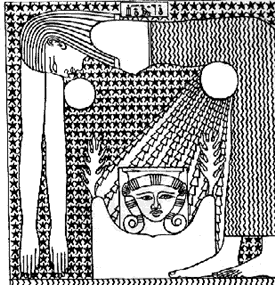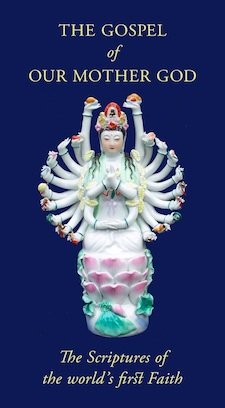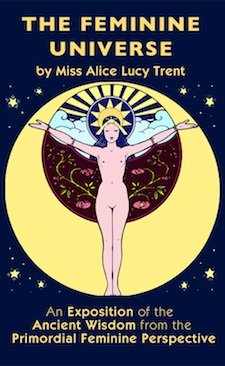Frau Holle
The Supreme Mother God
in fairy tale tradition
 The Supreme overarching Sky-Mother is remembered in folk-tradition as Frau Holle
The Supreme overarching Sky-Mother is remembered in folk-tradition as Frau HolleFrau Holle is known from a famous Grimm's fairy tale. In English translation it is usually called Mother Hulda.
While on the surface this is a fairly ordinary fairy tale (while containing the hidden depths of most such tales), it is a fascinating example of the preservation of the most ancient Déanic traditions in the form of folklore that we discussed in our main page on mythology and folklore.
The eponymous Frau Holle is rather more than a generic "old woman". In Germanic Pre-Christian folklore, Hulda, Holda, Holle and Holla were all names to denote a single Goddess. One who rules the weather: sunshine, snow and rain.
Here we have clearly a "sky-goddess", once again refuting the patriarchal myth that all feminine deities are "earth-mothers".
We should also note that the earliest patriarchal supreme-gods, such as Indra and Varuna were also sky-gods and that "weather-goddeses" were patriarchalised as supreme gods such as Zeus/Jupiter. We might indeed suspect that in Frau Holle, we have a fairy-tale memory of the Sky-Mother Ouranya, the celestial Thamë.
This conjecture is confirmed by the archeologist, professor Marija Gimbutas, who names Hulda (or Holda, Holla, Holle) as having originally been an ancient Germanic supreme goddess who predates most of the German pantheon, including deities such as Odin, Thor, Freya and Loki, continuing traditions of pre-Indo-European Neolithic Europe.
When Christianity slowly replaced Scandinavian paganism during the early Middle Ages, many of the old customs were gradually lost or assimilated into Catholic tradition. By the end of the High Middle Ages, Scandinavian "paganism" was almost completely marginalized and blended into rural folklore, in which the character of Mother Hulda eventually survived – not only in the fairy tale but in other folk traditions in the Germanic World.
For example, in the Hesse region of Germany, it is still common when it is snowing to say "Frau Holle is making her bed".
Much of the symbolism of Mother Hulda connects her not only with Sai Thamë, but with Werde, the triple-mother of Fate. This is not surprising, since in Déanic tradition, Sai Thamë is the mother of Sai Werde.
In the fairy tale, her Werdic nature is shown both in her association with spinning and weaving and in her cardinal role in shaping the girls' destinies which are at once influenced by her, and yet entirely made by the actions of the girls themselves.
Mother Hulda, even in patriarchal times, was the patroness and guardian of all maidens, and the nature of this surviving fairy tale with its all-female cast indicates its rootedness in a time when the "default characters" of any tale were female and not male.
The deep roots of Frau Holle in the traditions of pre-patriarchal "stone age" culture and in the intellectual complexities of Déanic doctrine are a subject we shall examine further when we present an Herthelan version of the story together with an exposition of some of its inner meanings.
Mother Hulda is one of the most demonstrably ancient fairy tale folk memories of Our Mother God.
See also:
Mother Holle, or Cliona and the Three Caskets: A traditional fairy tale containing much ancient metaphysical doctrine
The Secret of the Three Caskets: An in-depth metaphysical analysis of the above story
Send Questions or Comments on Frau Holle
Chapel of Our Mother God Homepage
All written material on this site is copyright. Should you wish to reproduce any portion please contact us for permission.
Facebook or Twitter
This section:
Stories and Symbols
Gospel of Our Mother God
The Gospel of Our Mother God is a collection of inspirational texts, prayers and daily inspiration for the Mother-Faith devotee or household.
The Feminine Universe
The Other Philosophy
Everything you have ever heard comes out of the patriarchal world-view. Its materialism, its religion, even its feminism. Here is the other way of seeing the world; the natural way: the way that everyone saw things before patriarchy and will again when patriarchy is long forgotten.

